Jupiter Medical Center
- 561.263.2234
- email us
- Jupiter, Florida, United States
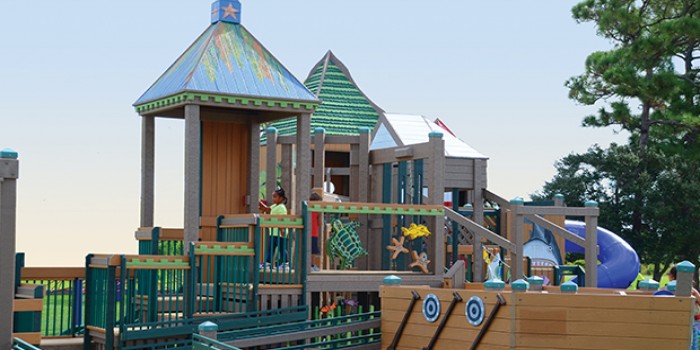
JUPITER, FL – March 8, 2017 –Dream. Build. Play! Custom-designed playgrounds unite communities in the best possible way – around the spirit of imagination and fun.
Close your eyes. Imagine being a child again. Now, imagine being told that you have the ability to design the playground of your dreams – nothing is too outlandish – imagine the best playground ever. Now imagine you have the ability to describe that playground to someone who will capture your desires for you – AND do their best to make your dreams a reality.
Sounds like a perfect childhood fantasy, doesn’t it?
Guess what? It isn’t a fantasy.
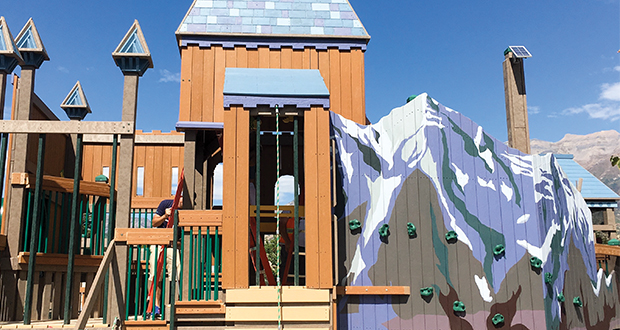
Thanks to a company with a very unique mission, that fantasy has become reality – and not just for a privileged few, but for entire communities.
“My dad, Bob Leathers, was an architect,” says Marc Leathers, President and Owner of Leathers & Associates. “In 1971, the parents at my elementary school asked him to design and build a playground for the school, but my dad didn’t want to do the usual cookie-cutter playground. He thought that the children who would be playing there on a daily basis should have some input in what their playground actually looked like and what features it contained.”
Leathers Sr. interviewed the students, compiled their ideas, and actually incorporated them into his custom-designed playground.
“The parents then helped by contributing the work to actually build the playground based on my father’s designs,” Leathers continues. “They also donated the materials to help keep costs down. It was his first customized, community-built playground. And it was the start of our company. Now, 45 years, 3,000 playgrounds, 50 states, and seven countries later, Leathers & Associates has changed the way people view playgrounds.”
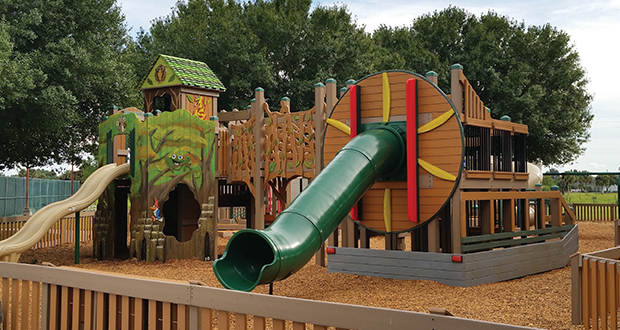
“Each playground is unique because it is a true reflection of the kids and the community that designed it. But there is one thing all the projects have in common – each is filled with a sense of purpose and community spirit. Whether it is a town or an organization that builds the playground, when groups of people unite for a common cause, it generates a tremendous feeling of friendship and common good. It is great to be a part of that unique energy,” Leathers says. “This is something we’ve experienced time and again as we’ve worked with cities, schools, science centers, park departments, community groups, churches, and even private citizens, to create one-of-a-kind, all-inclusive playgrounds of all sizes for all ages and abilities.”
The energy may be great, but that is a lot of input from a lot of varied sources. How does the actual process work?
“We have a step-by-step, proven process that involves the community from the beginning – and of course we are there to provide guidance and suggestions to prevent the creative process from becoming overwhelming or getting bogged down. After all, we’ve been designing playgrounds for over 45 years,” Leathers says. “We’re creative and inclusive, but we also follow blueprints.”
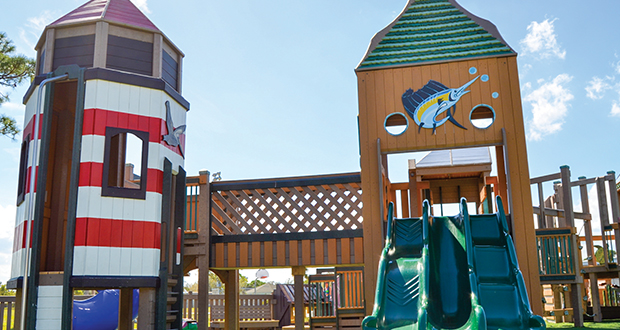
One of the first questions a client – be they private citizen or township – is asked is: Will this playground be built by skilled or volunteer labor?
“We have decades of experience coordinating the efforts of hundreds of skilled and unskilled people at one time,” explains Leathers. “Some people want professional contractors to build the playground and that’s fine. Some people; however, want the experience of building the playground as a community and using unskilled volunteer labor. That’s fine too. Our experts can easily guide them through the construction process. Some people want a build-team combination of unskilled labor and contractors, it is totally up to the clients.”
The Leathers team also reaches out to local artists and craftspeople to add unique design elements to the playgrounds. “We like to add embellishments such as mosaics, murals, even sculptures to the playgrounds in order to reflect the community – its local history and culture, and architecture” Leathers continues. “For example, we’ve designed dinosaur digs, historic storefronts, and sun dials – all elements that fit the ‘place’ of each unique playground.”
Another important factor is the playground site. “We help our clients select the best possible site and discuss where the equipment will actually be physically located on the site. We also make sure that any necessary approvals are in hand before any construction begins,” he says. “We can design a playground to fit any sized site, but we’ve found that the typical playground averages around 10,000 square feet. But, we’ve also designed 1,200-square-foot and 20,000-square-foot playgrounds, we like to say if the kids can dream it, we can make it happen.”
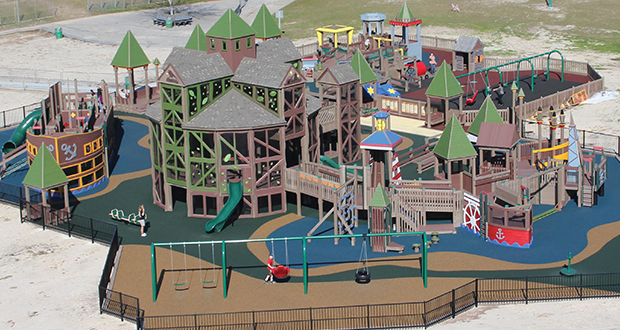
Steering committees are a helpful means of keeping the building of those dreams coordinated and running smoothly – especially when dealing with large groups. Leathers describes the organizational steps: “The entire design and build process can take two to nine months, depending on a wide variety of factors including the complexity of the design, the availability of volunteers, etc. For that reason, clients need to form a core group of people led by a general coordinator, who review designs, obtain permits and approvals, etc. If they need to raise funds or if it is a community build, the steering committee may need to have multiple members. Our designers meet with this committee and discuss the project and the expectations for the playground. These ideas will be incorporated with the design ideas provided by the children. ”
DESIGN DAY
The Design Day is when the creative magic actually happens and Leathers’ enthusiasm is infectious as he walks us through the process. “It is the most fun you can fit into 24 hours,” he says. “This is the day when we meet with the kids and ask them to create drawings of their dream playgrounds. For example, if we are working with a school, one of our designers will visit the school and spend several hours in the classrooms, brainstorming with the kids, getting them to contribute their ideas and their designs.”
The designer will then spend the rest of the afternoon synthesizing their drawings and ideas into a schematic design that incorporates the children’s desires, as well as the ideas presented by the steering committee, into a meaningful and cohesive whole.
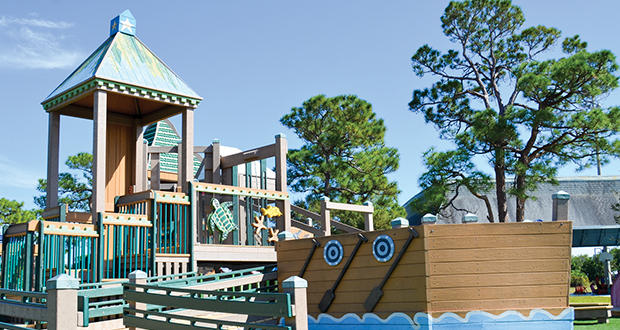
“We end Design Day with a community presentation that unveils the schematic plan to the kids and the adults,” Leathers says. “Often the local press is there and many people use this as an opportunity to kick-off fundraising and volunteer-recruiting efforts. The excitement is amazing and the kids really feel a sense of ownership.”
And then it is off to build a “tree house with rainbows that you can climb on and a special swing for our friend in a wheelchair next to the regular swings so we can swing together and a dinosaur rock climbing wall,” Leathers chuckles as he recounts some of the amazing playground requests that they have turned into reality. “We’ve built a Viking ship, a pineapple club house, a lighthouse, a sea turtle, and more. We integrate inclusive elements throughout to encourage shoulder-to-shoulder play between children of all abilities.”
“All of our designs exceed American Society for Testing and Materials (ASTM) and Americans with Disabilities Act (ADA) guidelines,” he continues. “Accessible options include slides, ships and vehicles with rocking or swinging platforms, low rings and ladders, misters, therapeutic swings, and four seater see-saws. The beauty of a custom-built playground is that it truly reflects the needs of the community.”
COMMUNITY BUILDING PROJECT
Although Leathers playgrounds can be custom-built by professional contractors for private individuals and organizations, it is the community builds that “are near and dear to our hearts,” Leathers says. “When the community builds, it builds the community.”
It may sound simple to say, but when hundreds of volunteers work together to transform an empty piece of ground into a community-designed, volunteer-built playground, the pride and sense of belonging is palpable. Not only are the children happy, the adults are too.
“Our construction consultants, along with volunteer construction captains, oversee quality and safety,” states Leathers. “The community volunteers participate as their schedules permit, typically working from a few hours to all five – or more – days on the build. The average build takes three days for a small playground, five for an average-sized one, and eight for larger projects. The number of volunteers working on the site helps with the speed too. Average-sized projects usually involve 75 to 80 volunteers and, as I said, take five to six days. We provide meals and childcare to keep volunteers happy and make sure that the parents themselves can participate in building the playground that their children designed.”
When the playground is finished, a Certified Playground Safety Inspector inspects it. Leathers & Associates verifies that all of the elements are constructed to meet Consumer Product Safety Commission (CPSC) and ASTM safety standards and guidelines, as well as ADA requirements.
Then, it is time to party and play.
Leathers says with a smile, “The celebrations for the grand openings of these custom-built playgrounds have been huge parties. There’s been hugging, cheering, and even a few tears. These playgrounds really do bring communities together.”
For more information about custom-designed playgrounds: Leathers & Associates, 877-564-6464, www.leathersassociates.com, Facebook: facebook.com/LeathersAssociates,
Instagram: @playgroundsbyla
•
Photos courtesy of Leathers & Associates